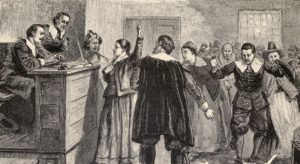1692
The execution of an American witch
By the end of the 1600s most of Western Civilization had abandoned the hunt for witches. Gradually across western Europe, the judicial proceedings that had resulted in the deaths of some 60,000 accused over the course of 200 years were less and less frequently put into motion. Almost a century before, the Spanish Inquisition had recognized that witchery was not an objective reality but rather the product of deluded minds. However, in Puritan New England an outburst of bizarre phenomena in a number of towns resulted in a series of hearings known as the Salem Witch Trials, trials in which hundreds were accused and twenty victims were put to death.
The disturbances began in early 1692 when two young girls began having fits and exhibiting signs of demonic possession. Soon more people were behaving strangely. The authorities reacted by arresting three women, the sort that made typical small-town scapegoats — a black slave, a beggar woman, and one who seldom attended church. As more and more people in surrounding villages claimed to be the object of spectral persecution, the arrests mounted and the accused now included prominent and godly community members.
In June seven men sitting as judges in the Court of Oyer and Terminer began to hear the cases. The first to be tried was Bridget Bishop, a thrice-married tavern owner of unsavoury reputation, who was accused of tormenting and striking down her targets by witchcraft. Though she denied even knowing her accusers, she was convicted speedily and executed by hanging on June 10.
The trials would continue until 1693 by which time twenty had been executed, one had been pressed to death for refusing to testify, and more had died in prison. Soon the communities began having second thoughts about the trials, particularly the admission of evidence of visions. By 1695 relatives of the convicted began to appeal for reversal of the sentences and restitution, pleas which were eventually granted. Many who had taken part in the trails and who had supported the accusations repented. One minister, John Hale, said ruefully: “Such was the darkness of that day, the tortures and lamentations of the afflicted, and the power of former presidents, that we walked in the clouds, and could not see our way.”
A similar, though less mortal, hysteria broke out in the 1980s when pagan feminists began to claim that over the centuries a Female Holocaust, operating as a tool of oppressive Christian patriarchy, had executed 9,000,000 women under the guise of witchcraft accusations. This fable was widely taken up by radical academics and was taught in universities. The National Film Board of Canada fell for this hoax as well, its notorious Studio D producing in 1990 The Burning Times, narrated by Starhawk, an enthusiast of the Goddess movement.
